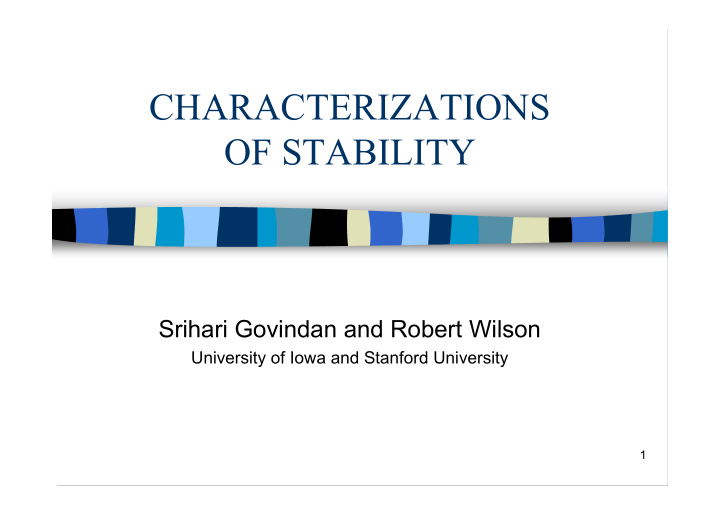



CHARACTERIZATIONS OF STABILITY Srihari Govindan and Robert Wilson University of Iowa and Stanford University 1
Motive for Equilibrium Selection The original Nash definition allows Multiple equilibria 1. Dominated strategies to be used 2. Implausible beliefs in extensive form 3. Unstable equilibria that disappear 4. if the game is perturbed Selection tries to exclude 2-3-4 2
Some Normal-Form Selections � Perfect Selten 1975 � Proper Myerson 1978 � Lexicographic Blume-Brandenberger- Dekel 1991 � Stable sets Kohlberg-Mertens 1986 Mertens 1989 3
Some Extensive-Form Selections � Subgame Perfect Selten 1965 � Extensive-form Perfect Selten 1975 � Sequential Kreps-Wilson 1982 � Quasi-Perfect van Damme 1984 ♦ A basic goal is to unify the Normal-Form and Extensive-Form perspectives 4
The Kohlberg-Mertens Program Specify desirable properties or axioms 1. – Assume set-valued selections Genericity of extensive game ⇒ (within a component) • all equilibria have the same outcome Define selections that achieve basic criteria 2. • Invariance, admissibility, backward & forward induction … � Mertens-Stability meets ALL their criteria but it depends on a topological construction We report results about � ♦ Hyperstability ♦ Stability 5
♦ Hyperstable Set of Equilibria � Definition : Each payoff perturbation of each inflation of the game has an equilibrium whose deflation is near the set – Inflation appends redundant pure strategies • Treats some mixed strategies as pure strategies – Deflation converts back to equivalent mixture of the original pure strategies � Inflation/Deflation invoke the Axiom of Invariance to presentation effects 6
Characterization of Hyperstable Components � Theorem : A component is hyperstable if and only if its index is nonzero – Thus hyperstability is a topological property Verify hyperstability by computing an index Relation to prior literature: � Definition : A component of fixed points is essential if each map nearby has a fixed point nearby � Theorem : A component of fixed points is essential iff its index is nonzero [O’Neill 1953] So hyperstable components are essential whereas Mertens 1989 imposes essentiality 7
Main Steps of Proof To show Index = 0 ⇒ not-hyperstable Index = 0 ⇒ ∃ map σ → G( σ ) = G ⊕ g( σ ) 1. to nearby perturbed games such that no σ near the component is an equilibrium of G( σ ) – This step extends KM's Structure Theorem Using simplicial approximation of map g 2. construct perturbed inflated games G*( ) Hyperstability ⇒ ( σ *) σ * is an equilibrium 3. of G*( σ ), where σ = deflation of σ * ⇒ σ is an equilibrium of G( σ ) ⇒ contradiction ! 8
♦ Stable Set of Equilibria � Definition : Each perturbed game obtained by shrinking the simplex of mixed strategies has an equilibrium near the set – Shrinking via η means each σ → (1- ε ) σ + εη – KM require a minimal stable set � A stable set is truly perfect – It is perfect against every tremble η � Stability excludes dominated strategies – But hyperstability allows them 9
Stability Characterization for 2 players Theorem : A closed set S contains a KM-stable set if and only if � For each tremble η there exist profiles σ & τ and ε ∈ (0,1], where σ ∈ S, such that each pure strategy used in either σ τ or σ and (1- ε ) τ + εη is an optimal reply to both – That is, perturbing τ by tremble η “respects preferences” [Blume-Brandenberger-Dekel 1991] – Generalizes the characterization for generic signaling games [Cho-Kreps & Banks-Sobel 1988] � N players : analog lexicographic condition 10
Axioms for Stability Our approach mixes normal-form and extensive-form criteria ♦ Our normal-form criterion is � Axiom 1 Weak Invariance Selection should be immune to inflation – That is, exclude presentation effects ♦ Our extensive-form criterion is � Axiom 2 Strong Backward Induction For an extensive game, trembles should select admissible sequential equilibria – Formulation of Axiom 2 uses ε -Quasi-Perfection 11
ε -Quasi-Perfect in Extensive Game with Perfect Recall � Definition : An action at an information set is optimal (for tremble η ) if it begins an optimal continuation strategy using beliefs induced by perturbations toward η � Definition : σ > 0 is ε -QP if suboptimal actions have cond. probabilities ≤ ε [van Damme 1984] � Proper ⇒ QP ⇒ Sequential equilibrium but QP excludes conditionally dominated strategies 12
Axiom 2 Using Strong Quasi-Perfect Require lower bounds on behavior strategies Then: � Axiom 2 : Each tremble should select some strong-QP-equilibrium from the set – Axiom 2 is stringent: robust to all trembles Requires that selection is ''truly'' Quasi-Perfect – Use of trembles is akin to Mertens' use of a “germ” inducing beliefs • Mertens-stable sets satisfy Axioms 1 and 2 • Could use lexicographic or equiproper instead? 13
Sufficiency Theorem � Theorem : Axioms 1 & 2 imply that a selected set includes a KM-stable set – Corollary: If an extensive game is generic then selection yields a stable outcome – Axiom Proper is sufficient for simple games (generic signaling, outside-option, and perfect- information games) but insufficient generally – Add Axiom Homotopy ⇒ Mertens-stable set 14
Sketch of Proof Construct inflated extensive game in which 1. each player chooses either the tremble with minimum probability ≥ ε or – – plays the original game with the maximum probability of a suboptimal strategy ≤ ε×ε Each tremble and ε -QP sequence induces a 2. lexicographic equilibrium The lexicographic equilibrium satisfies the 3. Characterization Theorem for KM-stable set 15
Summary Remarks Hyperstable component ⇔ essential set � – So select within a hyperstable component verified by computing its index – This is implicit in Mertens' construction Stability ⇐ Invariance + (in extensive game) � conditionally admissible strategies – Here, formulated via Quasi-Perfect In both cases, Invariance is the key tool ! � – Enables mixing normal-form and extensive-form criteria 16
η τ σ 17
Recommend
More recommend